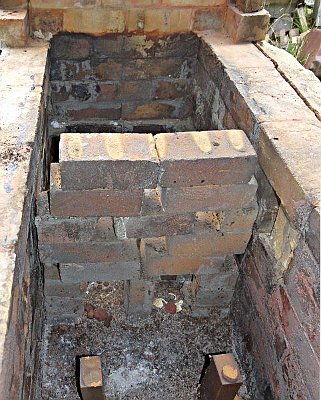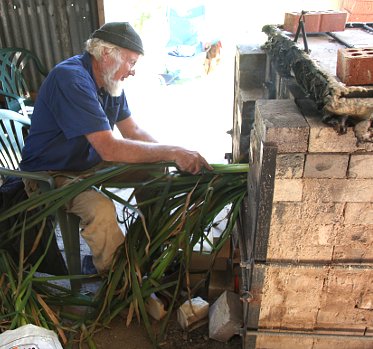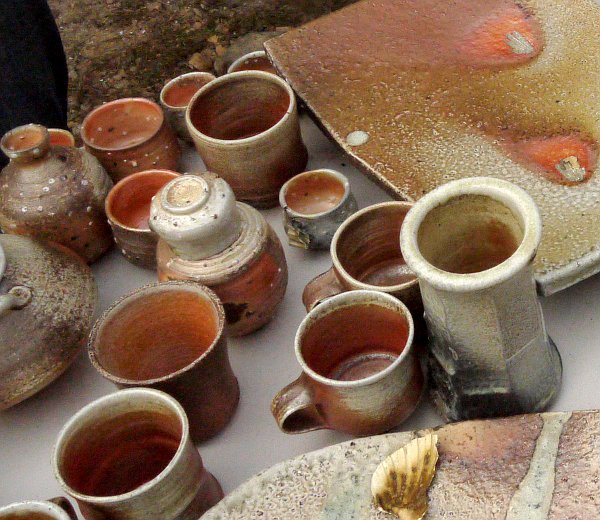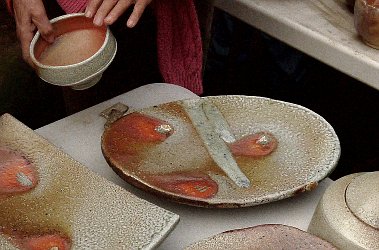|
The internal wall was an unintended variation. Because of the limited
time available for the firing it was decided to pack only bisqued pots,
and since Zoe and Dave do not bisque their pots they had none available
for the firing, except refires which had been left out in the rain and
were deemed likely to explode. The wall was built to separate the
refires from the rest of the kiln, and we rather pretentiously called
the separated area a sutema
|

|
|
The
firing was very much like our firings at Eungella, except that the wood
was much drier than it ever gets at home. The back of the kiln
showed its usual reluctance to heat up as much as the area behind the
firebox, and as usual was difficult to reduce. Because of the
absence of larger pots to block the flames at the top of the stack so
as to force them down the flames tended to motor along near the roof of
the chamber until forced down by the sutema wall. Continuous side
stoking through 2 ports relieved both the heat and reduction problem to
some extent. The sidestoking started at the first port when the
temperature behind the firebox was about 1000 C, and
at the second port when the front temperature reached
approximately 1130 C .The lengths and thickness
of the available sidestoking wood encouraged us to do quite a lot of
flamethrower stoking, which under some circumstances can yield short
term temperature rises but on the whole seemed no more effective than
ordinary stoking with shorter pieces of wood. Only towards the end of
the up cycle, when stoking temporarily ceased at the main firebox, and
flame throwers of thin, dry acacia sticks were used, did the
temperature at the back rise quickly. If we use
the sutema wall again we will move it to the firebox side of the second
side stoking port to see if side stoking in the sutema chamber makes
any difference.
|

|
Left: Arthur Rosser introducing bulrushes into the firebox for the
reduced cooling phase of the firing. An oxy probe was used to test that
reduction was maintained, but was not really necessary. About one
fertilizer bag of bulrushes was used.
|
Reduced cooling with
bulrushes as the reducing agent was uneventful, and of course quite
quick, taking only 53 minutes to lower the temperature from
1030 C to 880C according to the pyrometer in the oxy probe (located
about 65cm behind the firebox). Slightly lower
numbers were reported from the probes located closer to the exit flues.
All the numbers have to be regarded as approximate.
Slow oxidised cooling
below 900C was assisted by a gas burner, and the gas supply- burner
arrangement was untested prior to the firing. There did not seem to be
enough pressure to hold the kiln above 800 for the desired 4 hours, and
we had no way to increase the pressure. The temperature drifted
down to a lower temperature than we had planned, to a reported 770 C, before we sealed the kiln.
The temperature distribution
was not what we would have asked for, being very hot at the top of the
first bung (cone 13) and about cone 10 at the second
bung. The third bung was behind the sutema wall, and although the
pyrometers were moderately optimistic about the final temperature there
the well protected cones reported less than cone 9. We regard
cones 10-12 as acceptable and cone 13 as unnecessarily hot. If we use
the sutema wall again we will move it to the firebox side of the second
si |
 Some of the work from the firing
Some of the work from the firing
|
Results
On the clay body we use at Eungella the
pots looked very much like the pots fired at Eungella: good red
flashing on bare body where the ash effects were minimal, dark brown or
black (rather than the undesirable mid brown) at the next thickness of
ashing, and greenish glaze where the ash effect was greatest. "Red
shino" liner glaze - really a shino recipe using a proportion of iron
bearing clay - was excellent, with a lustrous surface effect in most
places. Shells used as wads produced good comet effects, and our high
iron dark wad clay behaved normally. Despite different woods and
different reducing medium, which could easily have resulted in very
different effects, the general resemblance to our usual work was
unmistakable. We are more than ever convinced that the reduced cooling
regime used is useful and transferable to different fuels.
Other clay bodies produced a wide range of results, many of them very attactive.
|

|
Platter ruined by snotters
Many
of the shelves used in the kiln had been purchased in used condition
and precisely what they had been used for was not known. Usually this
caused no trouble but one large silicon carbide shelf was placed across
the top of the kiln just behind the firebox, and the temperature
reached cone 13 at that position. The result was a liberal supply of
snotters, probably because the binder for the silicon carbide crystals
in the shelf had been affected by salt glazing. The platter shown was
fired on edge, and the snotters disrupted the intended comet mark
design.
|
| More images of fired pots |




